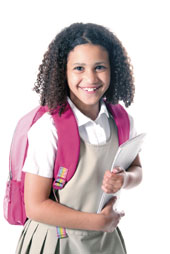 Overloaded backpacks used by children have received a lot of attention from parents, doctors, school administrators and the media in the past several years.
Overloaded backpacks used by children have received a lot of attention from parents, doctors, school administrators and the media in the past several years.
According to the U.S. Consumer Product Safety Commission, there were more than 21,000 backpack-related injuries treated at hospital emergency rooms, doctors’ offices and clinics in the year 2003. Injuries ranged from contusions, to sprains and strains, to the back and shoulder, as well as fractures.
“Back pain in children is not so uncommon anymore,” according to Lynn Knuth, DC, a chiropractic physician in Northeast Mesa. “Chiropractors and orthopaedic surgeons nationwide have seen an increase in children visiting their offices complaining of back and shoulder pain.”
The American Academy of Orthopaedic Surgeons recommends a child’s backpack should weigh no more than 15 to 20 percent of the child’s body weight. This figure may vary, however, depending on the child’s body strength and fitness.
Warning signs a backpack is too heavy
-
Change in posture when wearing the backpack
-
Struggling when putting on or taking off the backpack
-
Pain when wearing the backpack
-
Tingling or numbness
-
Red marks
Tips for safe backpack use
-
Wear both straps
-
Use of one strap shifts the weight to one side, causing muscle spasms and low back pain. This is true even with one-strap backpacks, which cross the body. By wearing two shoulder straps, the weight of the backpack is better distributed, and a well-aligned symmetrical posture is promoted.
-
Wear the backpack over the strongest mid-back muscles.
-
The size of the backpack should match the size of the child. It also is important to pay close attention to the way the backpack is positioned on the back. The backpack should rest evenly in the middle of the back. Shoulder straps should be adjusted to allow the child to put on and take off the backpack without difficulty and permit free movement of the arms. Make sure the straps are not too loose and the backpack does not extend below the low back.
Lighten the load
A heavy backpack forces the wearer to bend forward. Choose to carry only those items required for the day. Each night, remove articles, which can be left at home. When organizing the contents of the backpack, place the heaviest items closest to the back to reduce kinetic forces, which cause postural malalignment and overwork muscles.
Use proper lifting techniques
Bend at the knees, and use your legs to lift the backpack, placing one shoulder strap on at a time.
Tips for selecting a backpack
-
Ergonomically designed features, which enhance safety and comfort.
-
A padded back to reduce pressure on the back, shoulders and underarm regions while enhancing comfort.
-
Hip and chest belts to transfer some of the backpack weight from the back and shoulders to the hips and torso.
-
Multiple compartments to better distribute the weight in the backpack, to keep items secure and to ease access to the contents.
-
Compression straps on the sides or bottom of the backpack to stabilize the articles and compress the contents so the items are as close to the back as possible.
-
Reflective material to enhance visibility of the child to drivers at night.
Red Mountain Family Chiropractic accepts most insurance, but offers family discounts for the uninsured or underinsured for all members of your family. A large family of five will pay only $8.75 per adjustment on our Wellness Express Family program. Come in, and at $19 for your initial visit and spinal adjustment, your entire family can get the care they need for healthier, more productive lives.
Call (480) 924-7632 today to sign up for Wellness Express.

